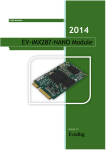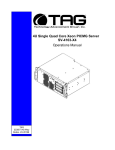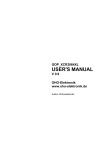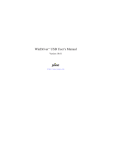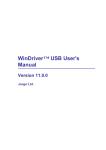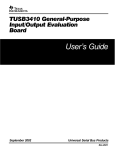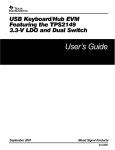Download Texas Instruments TUSB3210 User's Manual
Transcript
TUSB3210 Generic Evaluation Board User’s Guide 2005 MSP USB SLLU031A IMPORTANT NOTICE Texas Instruments Incorporated and its subsidiaries (TI) reserve the right to make corrections, modifications, enhancements, improvements, and other changes to its products and services at any time and to discontinue any product or service without notice. Customers should obtain the latest relevant information before placing orders and should verify that such information is current and complete. All products are sold subject to TI’s terms and conditions of sale supplied at the time of order acknowledgment. TI warrants performance of its hardware products to the specifications applicable at the time of sale in accordance with TI’s standard warranty. Testing and other quality control techniques are used to the extent TI deems necessary to support this warranty. Except where mandated by government requirements, testing of all parameters of each product is not necessarily performed. TI assumes no liability for applications assistance or customer product design. Customers are responsible for their products and applications using TI components. To minimize the risks associated with customer products and applications, customers should provide adequate design and operating safeguards. TI does not warrant or represent that any license, either express or implied, is granted under any TI patent right, copyright, mask work right, or other TI intellectual property right relating to any combination, machine, or process in which TI products or services are used. Information published by TI regarding third-party products or services does not constitute a license from TI to use such products or services or a warranty or endorsement thereof. Use of such information may require a license from a third party under the patents or other intellectual property of the third party, or a license from TI under the patents or other intellectual property of TI. Reproduction of information in TI data books or data sheets is permissible only if reproduction is without alteration and is accompanied by all associated warranties, conditions, limitations, and notices. Reproduction of this information with alteration is an unfair and deceptive business practice. TI is not responsible or liable for such altered documentation. Resale of TI products or services with statements different from or beyond the parameters stated by TI for that product or service voids all express and any implied warranties for the associated TI product or service and is an unfair and deceptive business practice. TI is not responsible or liable for any such statements. Following are URLs where you can obtain information on other Texas Instruments products and application solutions: Products Applications Amplifiers Data Converters DSP Interface Logic Power Mgmt Microcontrollers amplifier.ti.com dataconverter.ti.com dsp.ti.com interface.ti.com logic.ti.com power.ti.com microcontroller.ti.com Mailing Address: Texas Instruments Post Office Box 655303 Dallas, Texas 75265 Audio Automotive Broadband Digital Control Military Optical Networking Security Telephony Video & Imaging Wireless www.ti.com/audio www.ti.com/automotive www.ti.com/broadband www.ti.com/digitalcontrol www.ti.com/military www.ti.com/opticalnetwork www.ti.com/security www.ti.com/telephony www.ti.com/video www.ti.com/wireless Copyright 2005, Texas Instruments Incorporated EVM IMPORTANT NOTICE Texas Instruments (TI) provides the enclosed product(s) under the following conditions: This evaluation kit being sold by TI is intended for use for ENGINEERING DEVELOPMENT OR EVALUATION PURPOSES ONLY and is not considered by TI to be fit for commercial use. As such, the goods being provided may not be complete in terms of required design-, marketing-, and/or manufacturing-related protective considerations, including product safety measures typically found in the end product incorporating the goods. As a prototype, this product does not fall within the scope of the European Union directive on electromagnetic compatibility and therefore may not meet the technical requirements of the directive. Should this evaluation kit not meet the specifications indicated in the EVM User’s Guide, the kit may be returned within 30 days from the date of delivery for a full refund. THE FOREGOING WARRANTY IS THE EXCLUSIVE WARRANTY MADE BY SELLER TO BUYER AND IS IN LIEU OF ALL OTHER WARRANTIES, EXPRESSED, IMPLIED, OR STATUTORY, INCLUDING ANY WARRANTY OF MERCHANTABILITY OR FITNESS FOR ANY PARTICULAR PURPOSE. The user assumes all responsibility and liability for proper and safe handling of the goods. Further, the user indemnifies TI from all claims arising from the handling or use of the goods. Please be aware that the products received may not be regulatory compliant or agency certified (FCC, UL, CE, etc.). Due to the open construction of the product, it is the user’s responsibility to take any and all appropriate precautions with regard to electrostatic discharge. EXCEPT TO THE EXTENT OF THE INDEMNITY SET FORTH ABOVE, NEITHER PARTY SHALL BE LIABLE TO THE OTHER FOR ANY INDIRECT, SPECIAL, INCIDENTAL, OR CONSEQUENTIAL DAMAGES. TI currently deals with a variety of customers for products, and therefore our arrangement with the user is not exclusive. TI assumes no liability for applications assistance, customer product design, software performance, or infringement of patents or services described herein. Please read the EVM User’s Guide and, specifically, the EVM Warnings and Restrictions notice in the EVM User’s Guide prior to handling the product. This notice contains important safety information about temperatures and voltages. For further safety concerns, please contact the TI application engineer. Persons handling the product must have electronics training and observe good laboratory practice standards. No license is granted under any patent right or other intellectual property right of TI covering or relating to any machine, process, or combination in which such TI products or services might be or are used. Mailing Address: Texas Instruments Post Office Box 655303 Dallas, Texas 75265 Copyright 2005, Texas Instruments Incorporated EVM WARNINGS AND RESTRICTIONS It is important to operate this EVM within the input voltage range of 4 V to 6 V and the output voltage range of 3 V to 3.6 V. Exceeding the specified input range may cause unexpected operation and/or irreversible damage to the EVM. If there are questions concerning the input range, please contact a TI field representative prior to connecting the input power. Applying loads outside of the specified output range may result in unintended operation and/or possible permanent damage to the EVM. Please consult the EVM User’s Guide prior to connecting any load to the EVM output. If there is uncertainty as to the load specification, please contact a TI field representative. During normal operation, some circuit components may have case temperatures greater than 50°C. The EVM is designed to operate properly with certain components above 50°C as long as the input and output ranges are maintained. These components include but are not limited to linear regulators, switching transistors, pass transistors, and current sense resistors. These types of devices can be identified using the EVM schematic located in the EVM User’s Guide. When placing measurement probes near these devices during operation, please be aware that these devices may be very warm to the touch. Mailing Address: Texas Instruments Post Office Box 655303 Dallas, Texas 75265 Copyright 2005, Texas Instruments Incorporated Related Documentation From Texas Instruments Preface Read This First About This Manual This user’s guide describes the setup and operation of the TUSB3210 generic evaluation board. Familiarity with universal serial bus (USB) protocol and common laboratory testing equipment is required and assumed throughout this user’s guide. How to Use This Manual This document contains the following chapters: - Chapter 1—Hardware and Software Required - Chapter 2—EVM Operation Related Documentation From Texas Instruments - TUSB3210 Literature No. SLLS466 - TPS76333 Literature No. SLVS181 - TPS2042 Literature No. SLVS173 - MAX232 Literature No. SLLS047 - MAX3232 Literature No. SLLS410 - Bootcode Literature No. SLLU025 These files are available from Texas Instruments; contact technical support for assistance. v Trademarks Trademarks MacOS is a trademark of Apple Computer, Inc. Windows and Windows ME are trademarks of Microsoft Corporation. Other trademarks are the property of their respective owners FCC Warning This equipment is intended for use in a laboratory test environment only. It generates, uses, and can radiate radio frequency energy and has not been tested for compliance with the limits of computing devices pursuant to subpart J of part 15 of FCC rules, which are designed to provide reasonable protection against radio frequency interference. Operation of this equipment in other environments may cause interference with radio communications, in which case the user at his own expense will be required to take whatever measures may be required to correct this interference. vi Contents Contents 1 Hardware and Software Required . . . . . . . . . . . . . . . . . . . . . . . . . . . . . . . . . . . . . . . . . . . . . . . . 1.1 Equipment . . . . . . . . . . . . . . . . . . . . . . . . . . . . . . . . . . . . . . . . . . . . . . . . . . . . . . . . . . . . . . . . 1.2 Hardware Overview . . . . . . . . . . . . . . . . . . . . . . . . . . . . . . . . . . . . . . . . . . . . . . . . . . . . . . . . 1.3 Bill of Materials . . . . . . . . . . . . . . . . . . . . . . . . . . . . . . . . . . . . . . . . . . . . . . . . . . . . . . . . . . . . 1.4 Schematic Diagram . . . . . . . . . . . . . . . . . . . . . . . . . . . . . . . . . . . . . . . . . . . . . . . . . . . . . . . . 1-1 1-2 1-2 1-6 1-7 2 EVM Operation . . . . . . . . . . . . . . . . . . . . . . . . . . . . . . . . . . . . . . . . . . . . . . . . . . . . . . . . . . . . . . . . . 2.1 TUSB3210 Setup . . . . . . . . . . . . . . . . . . . . . . . . . . . . . . . . . . . . . . . . . . . . . . . . . . . . . . . . . . 2.2 Interfaces and USB Port . . . . . . . . . . . . . . . . . . . . . . . . . . . . . . . . . . . . . . . . . . . . . . . . . . . . 2.3 Power Supplies . . . . . . . . . . . . . . . . . . . . . . . . . . . . . . . . . . . . . . . . . . . . . . . . . . . . . . . . . . . . 2.4 Light Emitting Diodes (LEDs) . . . . . . . . . . . . . . . . . . . . . . . . . . . . . . . . . . . . . . . . . . . . . . . . 2.5 Jumpers and Switches . . . . . . . . . . . . . . . . . . . . . . . . . . . . . . . . . . . . . . . . . . . . . . . . . . . . . . 2.6 EEPROM . . . . . . . . . . . . . . . . . . . . . . . . . . . . . . . . . . . . . . . . . . . . . . . . . . . . . . . . . . . . . . . . . 2.7 GPIO Connector . . . . . . . . . . . . . . . . . . . . . . . . . . . . . . . . . . . . . . . . . . . . . . . . . . . . . . . . . . . 2-1 2-2 2-2 2-2 2-2 2-3 2-3 2-3 Figures 1−1 1−2 1−3 1−4 1−4 2−1 TUSB3210 Evaluation Equipment . . . . . . . . . . . . . . . . . . . . . . . . . . . . . . . . . . . . . . . . . . . . . . . TUSB3210 Evaluation Board . . . . . . . . . . . . . . . . . . . . . . . . . . . . . . . . . . . . . . . . . . . . . . . . . . . TUSB3210 EVM Connected to a Compact Flash Daughterboard . . . . . . . . . . . . . . . . . . . . TUSB3210 Printed-Circuit Board (REV 1.1)—Top Side . . . . . . . . . . . . . . . . . . . . . . . . . . . . . TUSB3210 Printed-Circuit Board (REV 1.2)—Top Side . . . . . . . . . . . . . . . . . . . . . . . . . . . . . GPIO Connector . . . . . . . . . . . . . . . . . . . . . . . . . . . . . . . . . . . . . . . . . . . . . . . . . . . . . . . . . . . . . 1-2 1-3 1-3 1-4 1-5 2-4 Tables 2−1 2−2 LED Description . . . . . . . . . . . . . . . . . . . . . . . . . . . . . . . . . . . . . . . . . . . . . . . . . . . . . . . . . . . . . . 2-2 Jumpers and Switches . . . . . . . . . . . . . . . . . . . . . . . . . . . . . . . . . . . . . . . . . . . . . . . . . . . . . . . . 2-3 vii viii Chapter 1 Hardware and Software Required The TUSB3210 generic EVM is designed for use with a personal computer running a USB-enabled operating system. The PC should be USB 1.1 specification compliant. This implies that the BIOS, chipsets, and operating system are all USB 1.1 specification compliant. If the BIOS is not specification compliant, the system may not boot up when USB devices are connected at power up, and the EVM may not function. Note that an ac/dc power supply adapter is optional equipment (but included), because the EVM can function in either bus-powered mode or self-powered mode. Topic Page 1.1 Equipment . . . . . . . . . . . . . . . . . . . . . . . . . . . . . . . . . . . . . . . . . . . . . . . . . . . . 1-2 1.2 Hardware Overview . . . . . . . . . . . . . . . . . . . . . . . . . . . . . . . . . . . . . . . . . . . 1-2 1.3 Bill of Materials . . . . . . . . . . . . . . . . . . . . . . . . . . . . . . . . . . . . . . . . . . . . . . . 1-6 1.4 Schematic Diagram . . . . . . . . . . . . . . . . . . . . . . . . . . . . . . . . . . . . . . . . . . . 1-7 Chapter Title—Attribute Reference 1-1 Running Title—Attribute Reference 1.1 Equipment Figure 1−1. TUSB3210 Evaluation Equipment USB EVM 1.2 Hardware Overview The TUSB3210 EVM hardware platform is 11 cm wide by 13 cm long. Throughout this document, text inside of parenthesis (ex.) denotes reference designators found on the TUSB3210 EVM. See Figure 1−2 for a photograph of the EVM. All jumpers are installed with the factory settings. See the jumper table for a description of settings, and make any required adjustments before using the EVM. The TUSB3210 EVM design allows great evaluation flexibility and provides a platform that is practical and easy to use. The EVM runs on a 12-MHz crystal and uses an I2C EEPROM. The EVM is set up for bus-powered operation using a 5-V to 3.3-V voltage regulator. The UART port is disabled. The firmware installed in the EEPROM allows USB HID-class-enabled operating systems such as Windows 98, Windows 2000, Windows ME, and MacOS to directly access it like a keyboard, although it does not have one. Reference firmware is installed and the source code is available to developers. The RS-232 port is available for monitoring 8052 MCU activity for debugging purposes. The port uses a one-to-one serial port cable instead of a null modem. Several test points have been added to the EVM for probing. Carefully review all setting changes prior to powering the EVM, as improper use could result in damage to some of the EVM components. This EVM is generic in the sense that it provides a 50-pin connector that allows access to the GPIO pins of the TUSB3210. It is meant to be used with another application-specific daughterboard that connects to the 50-pin connector. An example of such a daughterboard is shown in Figure 1−3. Users are responsible for developing their own application firmware for the target hardware device. LED (D4) provides power and suspend status to the 1-2 Running Title—Attribute Reference TUSB3210 device. A USB cable should be plugged into a USB port on a PC or into a USB hub and connected to the TUSB3210 EVM type-B connector (U3). Figure 1−2. TUSB3210 Evaluation Board Figure 1−3. TUSB3210 EVM Connected to a Compact Flash Daughterboard Chapter Title—Attribute Reference 1-3 Running Title—Attribute Reference Figure 1−4. TUSB3210 Printed-Circuit Board (REV 1.1)—Top Side 1-4 Running Title—Attribute Reference Figure 1−5. TUSB3210 Printed-Circuit Board (REV 1.2)—Top Side Chapter Title—Attribute Reference 1-5 Running Title—Attribute Reference 1.3 Bill of Materials Item Quantity Reference Part 1 3 (REV 1.1 board) C1, C4, C10 Capacitor, 0.1 µF 1 7 (REV 1.2 board) C1, C4, C9, C10, C12, C13, C14 Capacitor, 0.1 µF 2 2 C2, C5 Capacitor, 4.7 µF 3 1 C3 Capacitor, 10 µF 4 3 C6, C7, C8 Capacitor, 22 pF 5 5 (REV 1.1 board) C9, C11, C12, C13, C14 Capacitor, 1 µF 5 1 (REV 1.2 board) C11 Capacitor, 1 µF 6 1 D4 LED, RUN (red) 7 4 G1, G2, G3, G4 CON1 8 1 JDP1 DB 9−F (1−2−1 cable only) 9 1 JP1 Connector plug 25×2 10 1 JP2 Jumper (P3.0) 11 1 JP3 Jumper (P3.1) 12 1 JP4 Jumper 13 1 J1 AC adaptor 5 Vdc 14 1 Q1 NPN transistor, 2N2222A 15 1 Q2 PNP transistor, MMBT4403 16 1 RESET1 Pushbutton switch 17 6 R2, R3, R8, R9, R10, R18 Resistor, 100 kΩ 18 1 R4 Resistor, 1.5 kΩ 19 2 R5, R11 Resistor, 15 kΩ 20 2 R7, R6 Resistor, 33 Ω 21 2 R13, R12 Resistor, 1.2 kΩ 22 2 R14, R16 Resistor, 510 Ω 23 1 R15 Resistor, 10 Ω 24 1 R17 Resistor, 1 MΩ 25 2 S2, S1 Short 26 7 TP1, TP2, TP3, TP4, TP5, TP6, TP7 Test point 27 1 U1 Jumper, TPS76333DBV 28 1 U2 Jumper. JP(3) 29 1 U3 Type-B USB shield 30 1 U4 USB controller, TUSB3210 31 1 U5 MAX232 (REV 1.1 board) MAX3232 (REV 1.2 board) 32 1 U6 Eight-pin socket for 24LCxx 33 1 12 MHz SE3409-ND 1-6 Running Title—Attribute Reference 1.4 Schematic Diagram The complete schematic diagram of the TUSB3210 generic EVM is presented at the end of this document. Chapter Title—Attribute Reference 1-7 1-8 Chapter 2 EVM Operation This chapter describes the operation of the TUSB3210 EVM. Topic Page 2.1 TUSB3210 Setup . . . . . . . . . . . . . . . . . . . . . . . . . . . . . . . . . . . . . . . . . . . . . . 2-2 2.2 Interfaces and USB Port . . . . . . . . . . . . . . . . . . . . . . . . . . . . . . . . . . . . . . . 2-2 2.3 Power Supplies . . . . . . . . . . . . . . . . . . . . . . . . . . . . . . . . . . . . . . . . . . . . . . . 2-2 2.4 Light Emitting Diodes (LEDs) . . . . . . . . . . . . . . . . . . . . . . . . . . . . . . . . . . 2-2 2.5 Jumpers and Switches . . . . . . . . . . . . . . . . . . . . . . . . . . . . . . . . . . . . . . . . 2-3 2.6 EEPROM . . . . . . . . . . . . . . . . . . . . . . . . . . . . . . . . . . . . . . . . . . . . . . . . . . . . . 2-3 2.7 GPIO Connector . . . . . . . . . . . . . . . . . . . . . . . . . . . . . . . . . . . . . . . . . . . . . . 2-3 Chapter Title—Attribute Reference 2-1 Running Title—Attribute Reference 2.1 TUSB3210 Setup The TUSB3210 EVM supports many USB applications. The jumpers allow the flexibility to configure the EVM in various modes for evaluation purposes. Note that some modes require additional components not included with the EVM kit. The EVM comes in a default configuration that requires no additional components on the EVM. A full description of the TUSB3210 device is specified in the data manual (SLLS466). The PC must be running a USB-capable operating system. If necessary, configure the EVM based on the desired settings specified later in this section. Use a standard USB cable to connect the TUSB3210 EVM to a downstream port on the PC or to a USB HUB tier. 2.2 Interfaces and USB Port The EVM uses a standard type-B connector for the upstream port. An I2C serial interface is provided to access an I2C EEPROM. A UART port is embedded in the microcontroller and is connected to the RS-232 port on the EVM. The RS-232 port connection can be broken using the jumpers. See jumper settings for more details. All GPIO signals are available on the 50-pin connector JP1 for use by the specific application. 2.3 Power Supplies The TUSB3210 EVM requires a single positive 5-V power supply for operation. Two options are available for supplying power to the EVM: - Self-powered mode: a switching 5-V dc power supply plugged into (J1) - Bus-powered mode: 5-V power is supplied by the USB cable. Note that the supply needs to have a rating of at least 0.5 A. The EVM may fail to operate properly with less power. An onboard low-dropout regulator is used to generate a 3.3-V supply from the 5-V external supply. The red LED (D4) is on when the platform is powered. See also the Jumpers and Switches section. 2.4 Light Emitting Diodes (LEDs) Table 2−1. LED Description LED LED Description D4 Red LED on indicates that the EVM is powered on and not suspended. Red LED off indicates that the EVM is powered off or suspended. 2-2 Running Title—Attribute Reference 2.5 Jumpers and Switches Table 2−2 is provided to help set up and configure the EVM platform jumpers to the desired mode of operation. The EVM can download firmware code from the PC through a loading program (which may or may not be supplied with your EVM) or from an I2C EEPROM. A 5-V power source may be supplied from an external source or from the USB cable. If supplied from an external source, U2 must be set to position 2−3. If supplied from the USB cable, set U2 to position 1−2. The 5-V source is used to generate 3.3 V using an LDO regulator. JP2 and JP3 are used to connect P3.0 and P3.1 to R1OUT and T1IN of the RS232 connector, respectively. JP4 must be set to off when not using the MCU’s UART. Table 2−2. Jumpers and Switches Jumper/Switch Jumper/Switch Description U2 Position 1−2: 5-V bus power supply; position 2−3: 5-V dc or 5-V switching supply JP2 Position 1−2 on: connect P3.0 to R1OUT; position 1−2 off: disconnect P3.0 from R1OUT JP3 Position 1−2 on: connect P3.1 to T1IN; position 1−2 off: disconnect P3.1 from T1IN JP4 Position 1−2 on: supplies power to RS−232 transceiver; position 1−2 off: RS−232 transceiver is not powered. See Note. NOTE: JP4 supplies 5 V to the RS−232 transceiver for the REV 1.1 board. JP4 supplies 3.3 V to the RS−232 transceiver for the REV 1.2 board. 2.6 EEPROM The I2C EEPROM provides application-specific firmware. The TUSB3210 automatically reads the EEPROM at power up via the I2C bus. A header must be added to the application firmware before loading into the EEPROM. See the TUSB2136/3210 Bootcode Document for USB to General_Purpose Device ccontroller user’s guide (SLLU025) for a description of the header definition. The header may be generated automatically using the I 2C Header Generation Utility software provided with the device. The EVM ships with a preprogrammed EEPROM that has either keyboard controller firmware or compact flash reader firmware. It enumerates properly when connected to a USB host. 2.7 GPIO Connector The 50-pin GPIO connector provides access to the TUSB3210 GPIOs as well as some other control signals. Figure 2−1 shows the signals available on the connector. Chapter Title—Attribute Reference 2-3 Running Title—Attribute Reference Figure 2−1. GPIO Connector JP1 1 3 5 7 9 11 13 15 17 19 21 23 25 27 29 31 33 35 37 39 41 43 45 47 49 2 P0.0 P0.1 4 P0.2 P0.3 6 P0.4 P0.5 8 P0.6 P0.7 10 P1.1 P1.0 P1.3 12 P1.2 P1.5 14 P1.4 P1.7 16 P1.6 18 P2.1 P2.0 P2.3 20 P2.2 22 P2.4 P2.5 24 P2.6 P2.7 26 P3.0 P3.1 P3.2 P3.3 28 30 P3.4 P3.5 32 P3.6 P3.7 34 S2 S3 36 PUR BS 38 SDA SCL1 SUSP 3.3 Susp 40 42 RST 1.8 V 3.3 V 3.3 V 44 46 5V 5 V 48 GND GND 50 GND GND Connector Plug 25×2 2-4 A B C D E TP4 +5V U1 C1 0.1uF JP(3) 1 100KR2 2 + OUT 5 1 2 2 C4 C2 GND 3 EN NC 2 1 SHORT 2 1 2 +1.8V 100K SHORT 4.7uF 4 1 [Wait 10ms before enable 3.3V] 2 2 1 Vbus 1 IN 1 2 1 1 C3 10uF 1 +5V U2 3 TP5 R18 S2 S1 4 TPS76333DBV 3 0.1uF C 1 R3 100k 1 2 1 4 BS 1 2 AC adaptor 5VDC 2 J1 +3.3V 1 TP3 2 C5 4.7uF 1 E 2 MMBT4401 NPN Q1 PUR 3 1 1 Type B USB-Shield CON1 +5V 1 6 DM 2 G2 1 GND 3 SUSP 16 SUSP 1 2 100K R8 +1.8V 38 37 VREN VDDOUT 21 SELF/BUS 12 11 SCL SDA R6 2 1 G3 PUR DP0 DM0 P0.0 P0.1 P0.2 P0.3 P0.4 P0.5 P0.6 P0.7 43 44 45 46 47 48 49 50 P0.0 P0.1 P0.2 P0.3 P0.4 P0.5 P0.6 P0.7 P1.0 P1.1 P1.2 P1.3 P1.4 P1.5 P1.6 P1.7 31 32 33 34 35 36 40 41 P1.0 P1.1 P1.2 P1.3 P1.4 P1.5 P1.6 P1.7 P2.0 P2.1 P2.2 P2.3 P2.4 P2.5 P2.6 P2.7 22 23 25 26 27 28 29 30 P2.0 P2.1 P2.2 P2.3 P2.4 P2.5 P2.6 P2.7 P3.0/RxD/S0 P3.1/TxD/S1 P3.2 P3.3/INT1# P3.4/T0 P3.5 P3.6 P3.7 58 57 56 55 54 53 52 51 P3.0 P3.1 P3.2 P3.3 P3.4 P3.5 P3.6 P3.7 8 9 S2 S3 2 1 33 U3 U4 TP1 GND 4 5 CON1 2N2222A 2 2 17 18 19 R4 R7 1 33 DP 3 1 1 1.5k 1 15k R5 2 JP1 1 BS 1 TP2 CON1 R1 SCL SDA 33 G4 2 1 RST# CON1 SE3424-ND 12MHZ1 1M C6 C8 22pF 2 2 22pF 2 22pF 2 C7 1 +3.3V 1 1 R17 13 RST 14 15 20 TEST0 TEST1 TEST2 61 60 X1 X2 10 39 62 VCC1 VCC2 VCC3 5 24 42 59 GND1 GND2 GND3 GND4 S2 S3 P0.0 P0.2 P0.4 P0.6 P1.0 P1.2 P1.4 P1.6 P2.0 P2.2 P2.4 P2.6 P3.0 P3.2 P3.4 P3.6 S2 BS SCL SUSP RST# +3.3V +5V 1 3 5 7 9 11 13 15 17 19 21 23 25 27 29 31 33 35 37 39 41 43 45 47 49 1 3 5 7 9 11 13 15 17 19 21 23 25 27 29 31 33 35 37 39 41 43 45 47 49 P0.1 P0.3 P0.5 P0.7 P1.1 P1.3 P1.5 P1.7 P2.1 P2.3 P2.5 P2.7 P3.1 P3.3 P3.5 P3.7 S3 PUR SDA +3.3Susp +1.8V +3.3V +5V GND 2 4 6 8 10 12 14 16 18 20 22 24 26 28 30 32 34 36 38 40 42 44 46 48 50 2 4 6 8 10 12 14 16 18 20 22 24 26 28 30 32 34 36 38 40 42 44 46 48 50 CONN PLUG 25x2 P3.0 P3.1 9 JDP1 100K1 2 2 R10 100K1 [If S2 or S3 tied to ground, remove 100K pull-up to save power] 3 B C10 1 JP2 1 JP3 P3.0 P3.1 RST# C11 +3.3V 1 +3.3V 3 +3.3Susp 2 +3.3Susp C12 1uF 1 R13 C9 1uF MMBT4403 1.2K SCL SDA PNP R14 510 8pin Socket for 24LCxx 22 R15 2 1 2 SW PUSHBUTTON 10 A0 Vcc A1 WP A3 SCL Vss SDA 8 7 6 5 1 2 1 2 3 4 RESET1 C14 1uF 6 4 3 2 1 5 4 3 2 1 13 8 11 10 R1IN R2IN T1IN T2IN 1 3 4 5 2 6 C+ C1C2+ C2V+ V- R1OUT R2OUT T1OUT T2OUT 2 12 9 14 7 PWR232 C13 MAX232 1uF JP4 1 +5V 2 1 R16 510 JUMPER D4 base1.dsn Title 2 RUN(red) SUSP TUSB3210EVM REV1.1 SUSP 1 1 TP7 U6 1uF E 2 Q2 TP6 15K 1 1 RST# 7 5 U5 1 1 8 6 2 (P3.0) 2 (P3.1) C 1.2K 1 2 1 +3.3V R12 9 7 +3.3V +3.3V 0.1uF 8 R9 TUSB3210 R11 3 DB 9-F (1-2-1cable only) B Vbus G1 Size B Date: A B C D Document Number <Doc> Wednesday, July 13, 2005 Rev 1.1 Sheet E 1 of 1 A B C D E TP4 +5V U1 C1 0.1uF JP(3) R2 1 + 2 100K 5 OUT 1 GND 3 EN 2 1 2 1 +1.8V 4 0.1uF R3 100k 1 2 1 1 2 100K SHORT 4.7uF 4 NC SHORT C2 TPS76333DBV C 2 3 C4 2 TP5 R18 S2 1 IN 2 [Wait 10ms before enable 3.3V] 2 S1 1 C3 10uF 1 Vbus 2 1 1 2 4 1 +5V U2 3 1 2 BS 1 +3.3V 1 TP3 Power adaptor 5VDC J1 2 C5 4.7uF B 1 E 2 Vbus Type B USB-Shield CON1 +5V 1 6 R5 15k 1 R7 33 DM 2 G2 1 1 1 G3 GND 3 R6 33 Q1 3 PUR U4 PUR DP0 DM0 SUSP 16 SUSP 1 2 100K R8 +1.8V 38 37 VREN VDDOUT 21 SELF/BUS 12 11 SCL SDA 2 1 U3 2N2222A 2 2 17 18 19 R4 P0.0 P0.1 P0.2 P0.3 P0.4 P0.5 P0.6 P0.7 43 44 45 46 47 48 49 50 P0.0 P0.1 P0.2 P0.3 P0.4 P0.5 P0.6 P0.7 P1.0 P1.1 P1.2 P1.3 P1.4 P1.5 P1.6 P1.7 31 32 33 34 35 36 40 41 P1.0 P1.1 P1.2 P1.3 P1.4 P1.5 P1.6 P1.7 P2.0 P2.1 P2.2 P2.3 P2.4 P2.5 P2.6 P2.7 22 23 25 26 27 28 29 30 P2.0 P2.1 P2.2 P2.3 P2.4 P2.5 P2.6 P2.7 P3.0/RxD/S0 P3.1/TxD/S1 P3.2 P3.3/INT1# P3.4/T0 P3.5 P3.6 P3.7 58 57 56 55 54 53 52 51 P3.0 P3.1 P3.2 P3.3 P3.4 P3.5 P3.6 P3.7 8 9 S2 S3 2 TP1 GND 4 5 CON1 1 DP 3 1 1.5k 2 JP1 MMBT4401 NPN 1 1 1 TP2 CON1 SCL SDA 1 G4 R19 56K 1 RST# 2 CON1 1 SE3424-ND 12MHZ1 R1 100K C6 C8 22pF 2 2 22pF 2 22pF 2 C7 1 +3.3V 1 1 2 R17 1M 13 RST 14 15 20 TEST0 TEST1 TEST2 61 60 X1 X2 10 39 62 VCC1 VCC2 VCC3 5 24 42 59 GND1 GND2 GND3 GND4 S2 S3 P0.0 P0.2 P0.4 P0.6 P1.0 P1.2 P1.4 P1.6 P2.0 P2.2 P2.4 P2.6 P3.0 P3.2 P3.4 P3.6 S2 BS SCL SUSP RST# +3.3V +5V C10 2 2 R9 100K 1 R10 100K RST# RST# C11 TP6 2 1 2 3 4 +3.3V RESET1 1 1 P3.1 2 13 8 11 10 R1IN R2IN T1IN T2IN C12 0.1uF 1 3 4 5 2 6 C+ C1C2+ C2V+ V- C14 0.1uF C13 0.1uF Q2 +3.3V 3 +3.3Susp 2 +3.3Susp PNP R14 510 8pin Socket for 24LCxx 8 6 7 6 5 4 3 2 1 5 4 3 2 1 2 2 (P3.0) 2 (P3.1) C9 0.1uF MMBT4403 E 1.2K SCL SDA 9 7 U5 1 R13 1 JP2 1 JP3 P3.0 C 22 R15 2 1 2 SW PUSHBUTTON 10 A0 Vcc A1 WP A3 SCL Vss SDA 8 7 6 5 1 1uF R1OUT R2OUT T1OUT T2OUT 12 9 14 7 PWR232 MAX3232 JP4 1 +3.3V 2 1 R16 510 JUMPER D4 base1.dsn Title 2 RUN(red) SUSP TUSB3210 GEN EVM (REV1.2) SUSP 1 1 TP7 U6 15K 1 8 +3.3V 1 1 B 1.2K 1 2 1 +3.3V R12 3 JDP1 1 0.1uF R11 P0.1 P0.3 P0.5 P0.7 P1.1 P1.3 P1.5 P1.7 P2.1 P2.3 P2.5 P2.7 P3.1 P3.3 P3.5 P3.7 S3 PUR SDA +3.3Susp +1.8V +3.3V +5V GND 2 4 6 8 10 12 14 16 18 20 22 24 26 28 30 32 34 36 38 40 42 44 46 48 50 2 4 6 8 10 12 14 16 18 20 22 24 26 28 30 32 34 36 38 40 42 44 46 48 50 9 [If S2 or S3 tied to ground, remove 100K pull-up to save power] 3 1 3 5 7 9 11 13 15 17 19 21 23 25 27 29 31 33 35 37 39 41 43 45 47 49 CONN PLUG 25x2 P3.0 P3.1 TUSB3210 +3.3V 1 3 5 7 9 11 13 15 17 19 21 23 25 27 29 31 33 35 37 39 41 43 45 47 49 DB 9-F (1-2-1cable only) G1 Size B Date: A B C D Document Number <Doc> Wednesday, July 13, 2005 Rev 1.2 Sheet E 1 of 1























